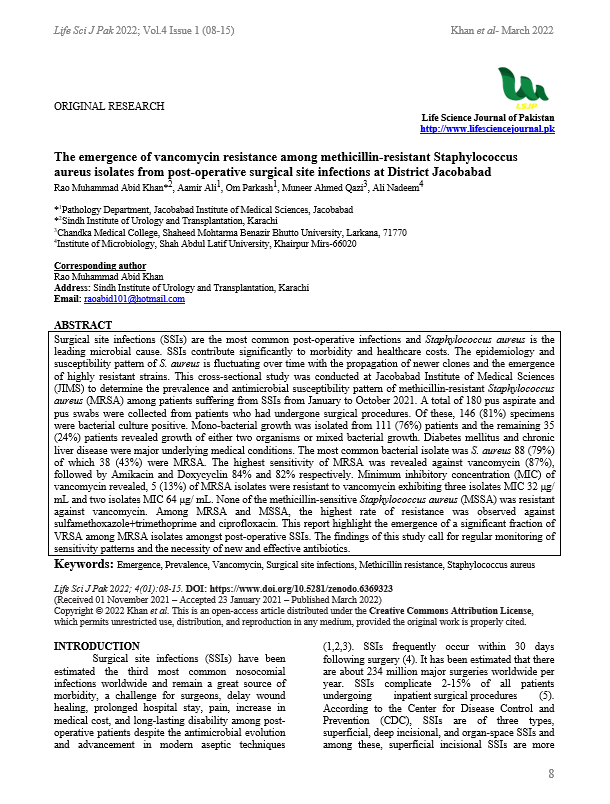The emergence of vancomycin resistance among methicillin-resistant Staphylococcus aureus isolates from post-operative surgical site infections at District Jacobabad
Main Article Content
Abstract
Surgical site infections (SSIs) are the most common post-operative infections and Staphylococcus aureus is the leading microbial cause. SSIs contribute significantly to morbidity and healthcare costs. The epidemiology and susceptibility pattern of S. aureus is fluctuating over time with the propagation of newer clones and the emergence of highly resistant strains. This cross-sectional study was conducted at Jacobabad Institute of Medical Sciences (JIMS) to determine the prevalence and antimicrobial susceptibility pattern of methicillin-resistant Staphylococcus aureus (MRSA) among patients suffering from SSIs from January to October 2021. A total of 180 pus aspirate and pus swabs were collected from patients who had undergone surgical procedures. Of these, 146 (81%) specimens were bacterial culture positive. Mono-bacterial growth was isolated from 111 (76%) patients and the remaining 35 (24%) patients revealed growth of either two organisms or mixed bacterial growth. Diabetes mellitus and chronic liver disease were major underlying medical conditions. The most common bacterial isolate was S. aureus 88 (79%) of which 38 (43%) were MRSA. The highest sensitivity of MRSA was revealed against vancomycin (87%), followed by Amikacin and Doxycyclin 84% and 82% respectively. Minimum inhibitory concentration (MIC) of vancomycin revealed, 5 (13%) of MRSA isolates were resistant to vancomycin exhibiting three isolates MIC 32 μg/ mL and two isolates MIC 64 μg/ mL. None of the methicillin-sensitive Staphylococcus aureus (MSSA) was resistant against vancomycin. Among MRSA and MSSA, the highest rate of resistance was observed against sulfamethoxazole+trimethoprime and ciprofloxacin. This report highlight the emergence of a significant fraction of VRSA among MRSA isolates amongst post-operative SSIs. The findings of this study call for regular monitoring of sensitivity patterns and the necessity of new and effective antibiotics.
Article Details

This work is licensed under a Creative Commons Attribution 4.0 International License.
 Life Science Journal of Pakistan
Life Science Journal of Pakistan
